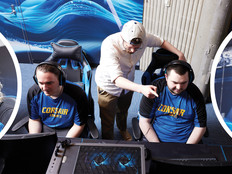Campus Dormitories Keep Up with Connection Demands
Around the time of the new millennium, first-year college students marveled at the connectivity of their dorm rooms. Coming from homes with dial-up Internet (or no Internet at all), they suddenly had access to Ethernet ports that could load web pages instantly and download entire songs in 30 seconds.
Fast-forward 15 years later, and that scenario has been turned on its head. Today’s students come from homes with fast Wi-Fi connections, and many spent their high school years streaming videos and gaming online. When they arrive on campus, they often find wireless connectivity that simply doesn’t live up to their standards. Many college and university IT departments have taken on the responsibility of not only accommodating business- and learning-related network traffic, but also setting up students with home-quality Wi-Fi in residence halls for purely recreational purposes.
Nolan Greene, a research analyst in IDC’s network infrastructure group, says that fast Wi-Fi now represents a baseline expectation for students arriving on college campuses: “It’s like you expect hot water in the bathroom. You expect unfettered, fast and easy Internet access for whatever you want to use it for.”
“They’re living on campus, and we don’t want to keep them from having a good time,” says William Gryder, communications manager at Dallas Baptist University, which recently undertook efforts to improve its residential network connections. “They’re able to do all this stuff at home, and we want them to be able to do those same things here.”
Building Campus Wi-Fi with All the Bells and Whistles
Colleges and universities that reported increased residential networking funding in 2015, up from the 38 percent of institutions in the previous year
SOURCE: ACUTA/NACUBO/ACUHO-I, “State of ResNet Report,” April 2015
Until recently, some Dallas Baptist students took to social media to complain about campus Wi-Fi, and even brought up the issue on their course evaluation forms. But the real problem wasn’t a lack of bandwidth, says Matt Murrah, vice president for technology. Instead, the university lacked a policy to allocate bandwidth equitably among students.
“It was almost like first-come, first-served,” Murrah says. “If we had a student who was downloading a bunch of videos, they were soaking up all the bandwidth, and then if another student tried to take a test, they either couldn’t get on, or the performance was so slow that it wasn’t worth their time.”
The first step in improving performance was to establish a policy on the university’s wireless controllers that set a hard 10-megabit-per-second maximum connection speed for each student user.
“We saw an immediate increase in reliability, and a lot fewer calls about performance issues,” Gryder says.
The cap was high enough to continue to allow users to engage in activities like video streaming and online gaming, but freed up enough bandwidth to allow additional users. Gryder says that students can still watch movies without lag time, but the cap forces the videos to load gradually over the course of a two-hour film, rather than all at once. Murrah says the 10Mb cap is very reasonable, and that the speed is faster than what he enjoys at home.
Dallas Baptist also tapped Aruba ClearPass — a network access manager — to throttle speeds for the very highest student users. After a student reaches 5 gigabytes of downloads in a single day, his or her maximum speed is bumped down from 10Mbps to 2Mbps. Then, if that student reaches 10GB of data, connection speed is cut down all the way to 256 kilobits per second for the rest of the day.
The university also upgraded hardware, installing 10GB Juniper EX3300 switches and 802.11ac Aruba AP 205 access points.
Before those changes, events such as the release of a mobile operating system update would cripple the network. Now, students don’t even notice such events.
“It was a real victory for us when we saw that the Wi-Fi wasn’t even affected by that,” Murrah says.
University Plays Networking Catch-Up
IT administrators at the College of Idaho also found themselves unprepared for the influx of wireless devices over the past several years.
“Students used to come in with just a laptop,” Systems Administrator Alan Price says. “Then we started seeing a phone and a laptop. The problem started when students all started showing up with smart TVs and gaming boxes, and they wanted to connect all of those to the network too.”
“We’re playing catch-up,” Price admits. “It’s nuts how quickly quality Wi-Fi went from being a kind of a luxury to being expected.”
Until recently, many of those alternative devices couldn’t connect to the college’s network at all because of a WPA2-Enterprise authentication system. The college implemented Aerohive ID Manager to help support a wider array of devices, but the IT team is still in the process of upgrading the network to fully support them all. A radio-frequency map has been created for one residence hall, and hardware was upgraded to Aerohive AP230 802.11ac wireless APs. Price says the college hopes to upgrade the remaining residence halls by the fall 2016 semester.
Students living in West Chester University residence halls didn’t even have wireless connectivity until a couple of years ago, Network Engineer Trevor Beach says. Instead, students at the Pennsylvania-based institution brought their own routers — a clunky, ad hoc solution that resulted in substantial interference. In summer 2014, the university undertook a massive hardware upgrade, installing approximately 1,100 802.11ac APs and upgrading from 100Mb switches to gigabit switches.
West Chester’s APs are distributed in every other dorm room, giving students ample capacity, Beach says.
“You’re talking a maximum of six or seven students on an AP with a 1Gb link. That still gives students 100Mb worth of traffic each. We’re nowhere near exceeding our limit,” he says. “Their expectation is: ‘I’m on wireless all of the time at home; I should be able to come here and do the exact same thing.’”









